| [1] | ABID, M., ABBAS, N. SHERWANI, R.A.K. AND NAZIR, H. Z. (2016). Improved Ratio Estimators for the population mean using non-conventional measure of dispersion. Pakistan Journal of Statistics and Operations Research, XII (2), 353-367. |
| [2] | COCHRAN, W. G. (1940). The Estimation of the Yields of the Cereal Experiments by Sampling for the Ratio of Grain to Total Produce. The Journal of Agric. Science, 30, 262-275. |
| [3] | JERAJUDDIN, M., KISHUN, J. (2016). Modified Ratio Estimators for Population Mean Using Size of the Sample, Selected From Population, IJSRSET, 2, 2, 10-16. |
| [4] | KADILAR, C., CINGI, H. (2004). Ratio estimators in simple random sampling, Applied Mathematics and Computation, 151, 893–902. sss. |
| [5] | KADILAR, C., CINGI, H. (2006a). An improvement in estimating the population mean by using the correlation co-efficient, Hacettepe Journal of Mathematics and Statistics, 35 (1), 103–109. |
| [6] | Gupta, R.K. and Misra, S. (2006). Estimation of Population Variance Using Ratio Type Estimator” in Indian Journal of Mathematics and mathematical Sciences. Vol.2, No.2, 169-176. |
| [7] | Misra, S. and Gupta, R.K. (2008). Almost Unbiased Jacknifed Ratio type estimator of Population variance” in International Journal of Agricultural and Statistical Sciences (IJASS), Vol.4, No.2, 345-350. |
| [8] | Misra, S., Gupta, R.K. and Shukla, A.K. (2012). Generalized Class of Estimators for Estimation of finite Population Variance” in International Journal of Agricultural and Statistical Sciences, Vol. 8, No. 2, pp. 447-458. |
| [9] | KADILAR, C., CINGI, H. (2006b). Improvement in estimating the population mean in simple random sampling, Applied Mathematics Letters, 19, 75–79. |
| [10] | KADILAR, C., CINGI, H. (2009). Advances in sampling theory - Ratio method of estimation, Bentham Science Publishers. |
| [11] | KOYUNCU, N., KADILAR, C. (2009). Efficient estimators for the population mean, Hacettepe Journal of Mathematics and Statistics, 38(2), 217–225. |
| [12] | MUKHOPADHYAY, P. (2009). Theory and methods of survey sampling, PHI Learning, 2nd edition, New Delhi. |
| [13] | MURTHY, M.N. (1967). Sampling Theory and Methods; Statistical Publishing Society, Calcutta. |
| [14] | SINGH, G.N. (2003). On the improvement of product method of estimation in sample surveys, Journal of Indian Society of Agricultural Statistics, 56 (3), 267–265. |
| [15] | SINGH, H. P., TAILOR, R. (2003). Use of known correlation coefficient in estimating the finite population means, Statistics in Transition, 6 (4), 555–560. |
| [16] | SINGH, D., CHAUDHARY, F. S. (1986). Theory and analysis of sample survey designs, New Age International Publisher, New Delhi. |
| [17] | SINGH, H. P., TAILOR, R. (2003). Use of known correlation coefficient in estimating the finite population means, Statistics in Transition, 6 (4), 555–560. |
| [18] | SINGH, H. P., TAILOR, R. (2005). Estimation of finite population mean with known co-efficient of variation of an auxiliary variable, Statistica, anno LXV, 3, 301–313. |
| [19] | SISODIA, B.V.S. and DWIVEDI, V.K. (1981). A Modified Ratio Estimator using Coefficient of Variation of Auxiliary Variable; Jour. of Indian. Soc. of Agri. Stat., Vol. 33(1). Pp. 13–18. |
| [20] | SUBRAMANI, J. (2013). Generalized modified ratio estimator of finite population mean, Journal of Modern Applied Statistical Methods, 12 (2), 121–155. |
| [21] | SUBRAMANI, J., KUMARAPANDIYAN, G. (2012a). Estimation of population mean using coefficient of variation and median of an auxiliary variable, International Journal of Probability and Statistics, 1 (4), 111–118. |
| [22] | SUBRAMANI, J., KUMARAPANDIYAN, G. (2012b). Modified ratio estimators using known median and coefficient of kurtosis, American Journal of Mathematics and Statistics, 2 (4), 95–100. |
| [23] | SUBRAMANI, J., KUMARAPANDIYAN, G. (2012c). Estimation of population mean using known median and coefficient of skewness, American Journal of Mathematics and Statistics, 2 (5), 101–107. |
| [24] | SUBRAMANI, J., KUMARAPANDIYAN, G. (2013a). Estimation of population mean using deciles of an auxiliary variable, Statistics in Transition-New Series, 14 (1), 75–88. |
| [25] | SUBRAMANI, J., KUMARAPANDIYAN, G. (2013b). A new modified ratio estimator of population mean when median of the auxiliary variable is known, Pakistan Journal of Statistics and Operation Research, Vol. 9 (2), 137–145. |
| [26] | TAILOR, R., SHARMA, B. (2009). A modified ratio-cum-product estimator of finite population mean using known coefficient of variation and coefficient of kurtosis, Statistics in Transition-New Series, 10 (1), 15–24. |
| [27] | UPADHYAYA, L.N. & SINGH, H.P. (1999). Use of transformed auxiliary variable in estimating the finite population means, Biometrical Journal 41 (5), 627–636. |
| [28] | YADAV, S.K. AND PANDEY, H. (2011). Improved Exponential Estimators of Population Mean Using Qualitative Auxiliary Information under Two Phase Sampling, Investigations in Mathematical Sciences, Vol. 1, 85-94. |
| [29] | YADAV, S. K. AND ADEWARA, A.A. (2013). On Improved Estimation of Population Mean using Qualitative Auxiliary Information, Mathematical Theory and Modeling, 3, 11, 42-50. |
| [30] | YADAV, S.K; MISHRA, S.S. AND SHUKLA, A.K. (2014). Improved Ratio Estimators for Population Mean Based on Median Using Linear Combination of Population Mean and Median of an Auxiliary Variable. American Journal of Operational Research, 4, 2, 21-27. |
| [31] | YADAV, S.K; MISHRA, S.S. AND SHUKLA, A.K. (2015). Estimation Approach to Ratio of Two Inventory Population Means in Stratified Random Sampling, American Journal of Operational Research, 5, 4, 96-101. |
| [32] | YADAV, S. K; MISHRA, S. S; SHUKLA, A.K; KUMAR, S. AND SINGH, R. S. (2016a). Use of Non-Conventional Measures of Dispersion for Improved Estimation of Population Mean, American Journal of Operational Research, 6, 3, 69-75. |
| [33] | YADAV, S. K; GUPTA, SAT; MISHRA, S. S. AND SHUKLA, A. K. (2016b). Modified Ratio and Product Estimators for Estimating Population Mean in Two-Phase Sampling, American Journal of Operational Research, 6, 3, 61-68. |
| [34] | YADAV, S.K; SUBRAMANI, J; MISHRA, S.S. AND SHUKLA, A .K. (2016c). Improved Ratio-Cum-Product Estimators of Population Mean Using Known Population Parameters of Auxiliary Variables, American Journal of Operational Research, 6, 2, 48-54. |
| [35] | YADAV, S.K; MISRA, S; MISHRA, S.S. AND CHUTIMAN, N. (2016d). Improved ratio estimators of population mean in Adaptive Cluster Sampling, Journal of Statistics Applications and Probability Letter, 3, 1, 1-6. |
| [36] | YAN, Z. & TIAN, B. (2010). Ratio Method to the Mean Estimation using Coefficient of Skewness of Auxiliary Variable; ICICA, Part-II, CCIS 106, pp. 103 – 110. |
| [37] | Gupta, R.K. and Yadav, S.K. (2017). New Efficient Estimators of Population Mean Using Non-Traditional Measures of Dispersion. Open Journal of Statistics, 7, 394-404. https://doi.org/10.4236/ojs.2017.73028. |



 be a bivariate sample of size n taken from (X, Y) using a SRSWOR scheme. Let
be a bivariate sample of size n taken from (X, Y) using a SRSWOR scheme. Let  and
and  respectively be the population means of the auxiliary and the study variables, and let
respectively be the population means of the auxiliary and the study variables, and let  and
and  be the corresponding sample means. It is well known and has been seen in practice that in simple random sampling scheme, sample means
be the corresponding sample means. It is well known and has been seen in practice that in simple random sampling scheme, sample means  and
and  are unbiased estimators of population means of
are unbiased estimators of population means of  and
and  respectively. Population mean is one of the very important measures of central tendency in almost all fields of society including field of Medical sciences, Biological sciences, Agriculture, Industry, social sciences, humanities etc. Thus the estimation of population mean is of great significance in above fields. In the present manuscript a modified ratio type estimator of population mean of the study variable using information on size of the sample has been proposed and its large sample properties have been studied up to the first order of approximation.
respectively. Population mean is one of the very important measures of central tendency in almost all fields of society including field of Medical sciences, Biological sciences, Agriculture, Industry, social sciences, humanities etc. Thus the estimation of population mean is of great significance in above fields. In the present manuscript a modified ratio type estimator of population mean of the study variable using information on size of the sample has been proposed and its large sample properties have been studied up to the first order of approximation.  is the corresponding sample mean
is the corresponding sample mean  given by,
given by,

 .Cochran (1940) used the positively correlated auxiliary variable with the study variable and proposed the following usual ratio estimator of population mean as,
.Cochran (1940) used the positively correlated auxiliary variable with the study variable and proposed the following usual ratio estimator of population mean as, 

 ,
,  .In literature various modified estimators of population mean of study variable using auxiliary variables have been given by various authors. For detailed study of the modified ratio type estimators, latest references can be made of Kadilar and Cingi (2004, 2006a, 2006b, 2009), Singh (2003), Singh and Tailor (2003, 2005), Koyuncu and Kadilar (2009), Subramani (2013), Subramani and Kumarapandiyan (2012a,b,c, 2013a,b), Tailor and Sharma (2009), Yan and Tian (2010), Yadav and Pandey (2011), Yadav and Adewara (2013), Yadav et al. (2014, 2015), Yadav et al. (2016a, 2016b, 2016c, 2016d), Abid et al. (2016).Following table-1 represents some modified estimators their constants, biases and mean squared errors.
.In literature various modified estimators of population mean of study variable using auxiliary variables have been given by various authors. For detailed study of the modified ratio type estimators, latest references can be made of Kadilar and Cingi (2004, 2006a, 2006b, 2009), Singh (2003), Singh and Tailor (2003, 2005), Koyuncu and Kadilar (2009), Subramani (2013), Subramani and Kumarapandiyan (2012a,b,c, 2013a,b), Tailor and Sharma (2009), Yan and Tian (2010), Yadav and Pandey (2011), Yadav and Adewara (2013), Yadav et al. (2014, 2015), Yadav et al. (2016a, 2016b, 2016c, 2016d), Abid et al. (2016).Following table-1 represents some modified estimators their constants, biases and mean squared errors.
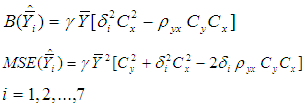

 is a suitably chosen constant to be defined such that the mean squared error of the proposed estimator is minimum. To study the large sample properties of the proposed estimator, we define,
is a suitably chosen constant to be defined such that the mean squared error of the proposed estimator is minimum. To study the large sample properties of the proposed estimator, we define,  and
and  such that
such that  for
for  and
and  ,
,  ,
,  .Expressing (6) in terms of
.Expressing (6) in terms of  , we have
, we have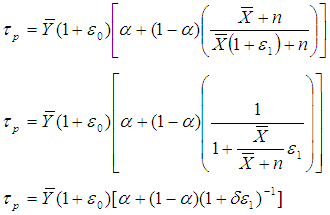
 We assume that
We assume that  , so that
, so that  may be expanded. Now expanding the right-hand side of (7), we have,
may be expanded. Now expanding the right-hand side of (7), we have,


 from both sides of (10), we get
from both sides of (10), we get
 as
as

 , up to the first order of approximation, as
, up to the first order of approximation, as 
 Thus the minimum MSE of
Thus the minimum MSE of  is,
is,




 or,
or, 
 Population 2: Y = Output for 80 factories in a region and X = Fixed Capital
Population 2: Y = Output for 80 factories in a region and X = Fixed Capital 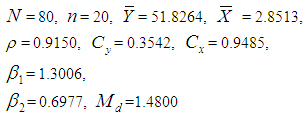 Mukhopadhyay (2009)Population 3: Y = Output for 40 factories in a region and X = Number of workers
Mukhopadhyay (2009)Population 3: Y = Output for 40 factories in a region and X = Number of workers  Population 4: Y = Output for 40 factories in a region and X = Fixed Capital
Population 4: Y = Output for 40 factories in a region and X = Fixed Capital  Following Table-2 and Table-3 represents the biases, mean squared errors of proposed and existing estimators of population mean. Table-4 shows the efficiencies of the proposed estimator over other existing estimators of population mean.
Following Table-2 and Table-3 represents the biases, mean squared errors of proposed and existing estimators of population mean. Table-4 shows the efficiencies of the proposed estimator over other existing estimators of population mean.
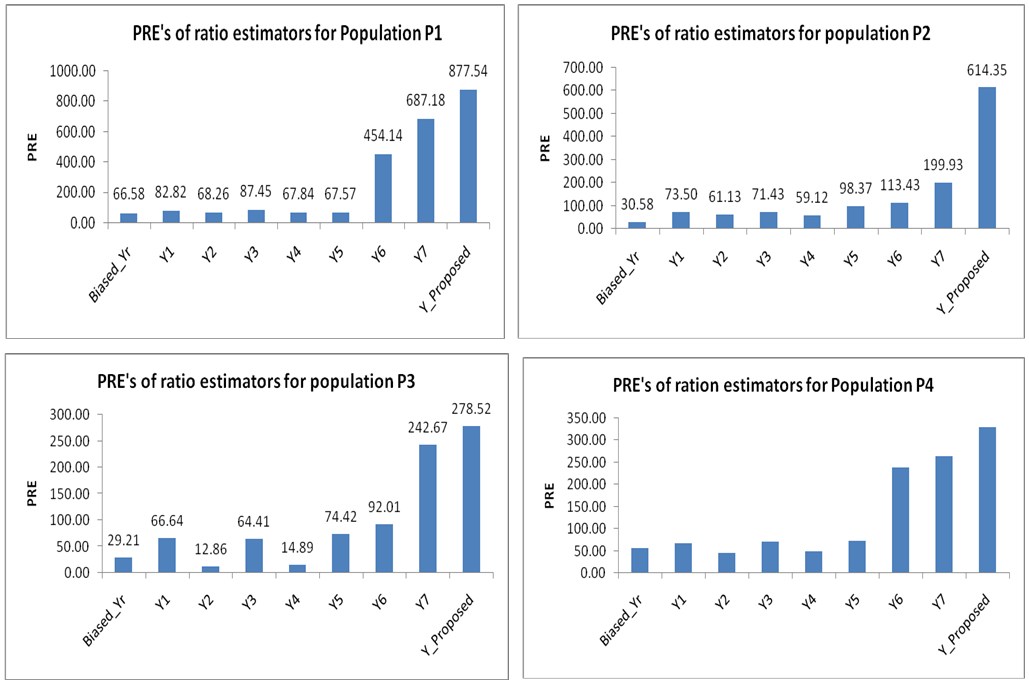

 Abstract
Abstract Reference
Reference Full-Text PDF
Full-Text PDF Full-text HTML
Full-text HTML
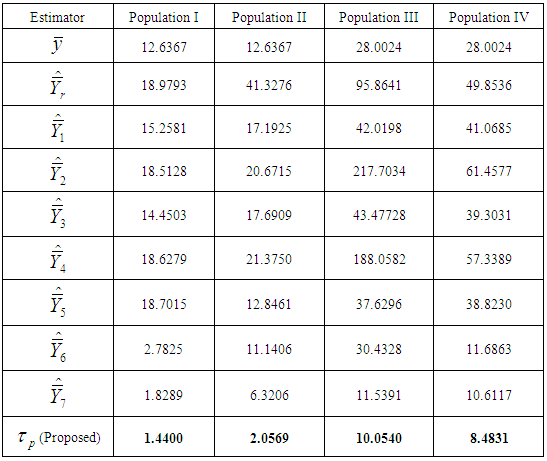
 for four natural populations
for four natural populations